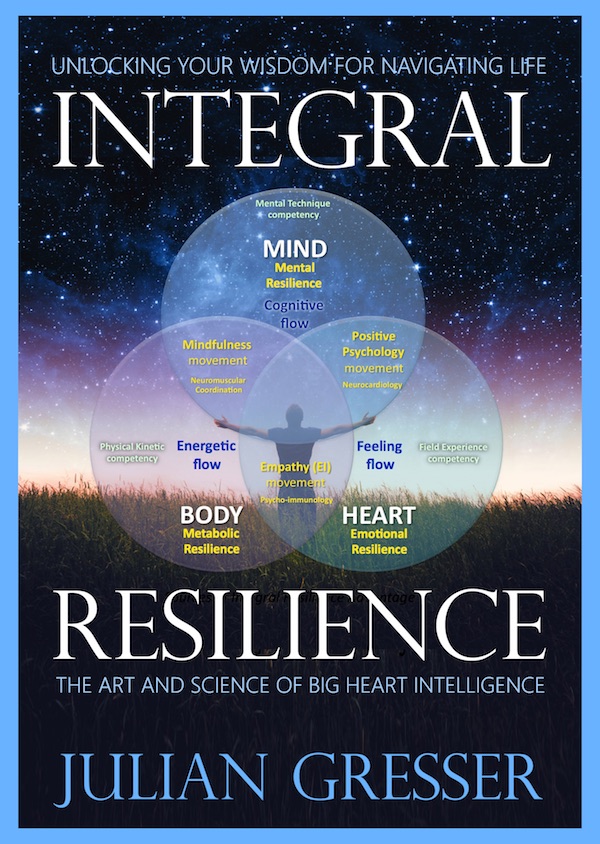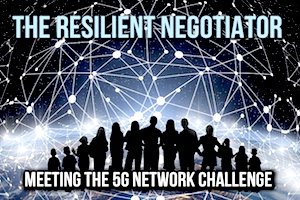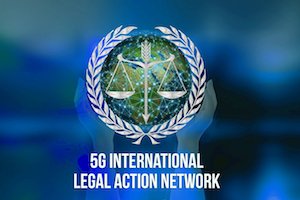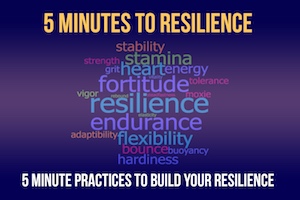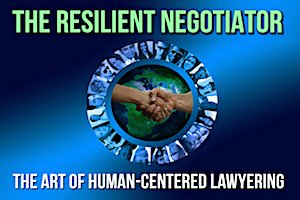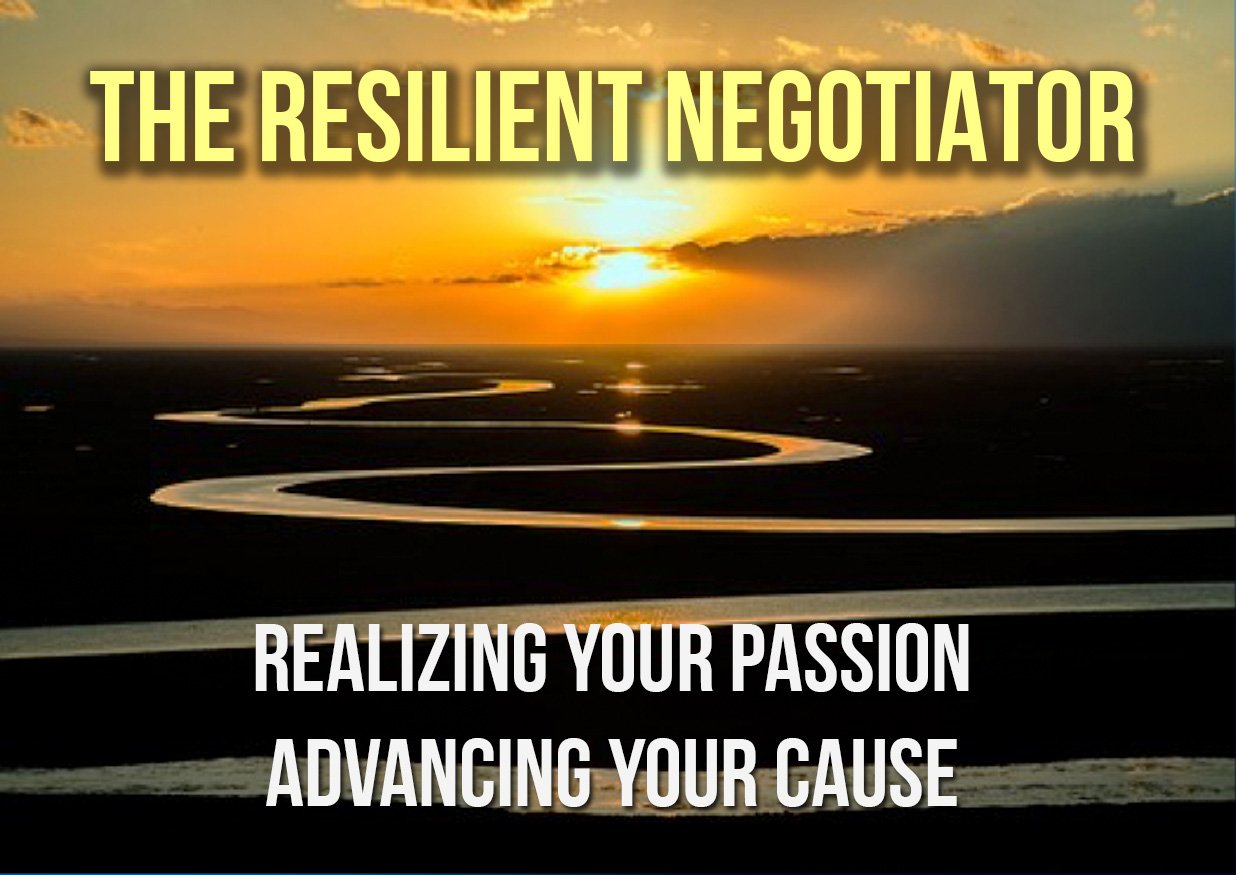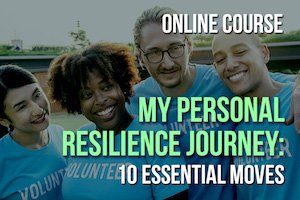Author: Julian Gresser
Self-Care
“No amount of self-improvement can make up for any lack of self-acceptance.”
Robert Holden, Ph.D. author, psychologist, philosopher
Blue Cliff Record Case # 94 —Dongshan is well.
Dongshan was ill. A student asked, “You’re unwell. Is there someone, after all, who isn’t sick?” Dongshan said, “There is.” “Does the one who isn’t sick take care of you?” continued the student; “I’m actually taking care of that one.” Dongshan observed. “What’s it like when you take care of that one?” continued the student. “Then I don’t see that there is illness,” Dongshan replied.
Audio–Caring for That One
Actions:
- Simply enjoy being you.
- And make happiness a first priority in your life.
Resilience Advantage:
- When you can accept (love) yourself, you begin to love your life more deeply, no matter what happens; they are inseparable. Everything—inner and outer—suddenly shifts.
Reference Links:
- Robert Holden, Ph.S. https://www.youtube.com/watch?v=PjFNa59SHgo
- Stop, Look, Go-–https://vimeo.com/150279303
- Art Thou Troubled?- https://www.opera-arias.com/handel/rodelinda/art-thou-troubled/
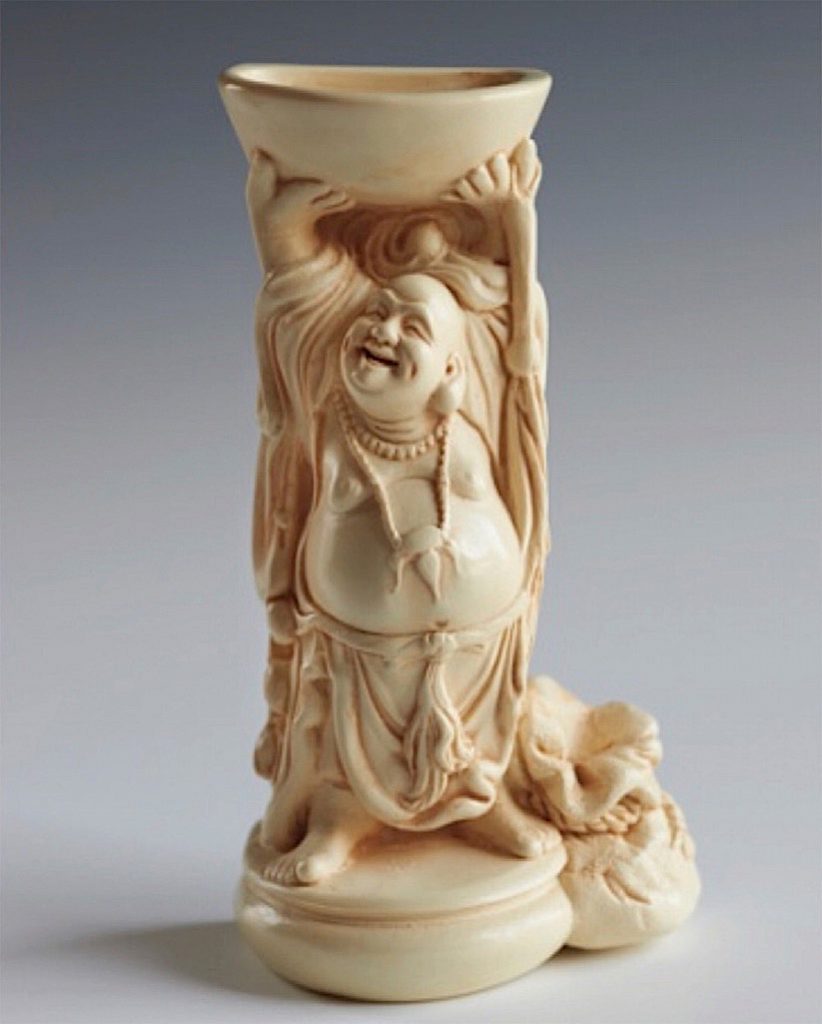
Caring for That One (Audio Transcript)
Is it possible to be fully engaged in the world and yet be free like Pu-tai, depicted directly above in all his glory? Pu-tai was a semi-historical Chinese monk who lived around the 10th century in the Wuyue kingdom. Pu-tai wandered the world aimlessly, unencumbered by earthly belongings and impediments, bringing joy and happiness wherever he traveled. I confess it is a bit Romantic for a lawyer and health justice advocate to fancy a part of himself like Pu-tai. Notwithstanding, I feel impelled to record my discoveries.
Self-care begins with happiness. But how to be happy? A basic step is simply to accept and enjoy being who we are. And from this root stems loving our life. When we enjoy simply being ourselves and loving our life, we are shielded from the buffets, disappointments, and reversals of life. We become what the psychologists call “field independent.”
But we cannot simply wave a wand and mandate loving our life. It is perhaps odd to think of it in this way, but it does seem for all those who don’t live a charmed life, as some do, where everything comes easy, that there actually are practical clues.
The first, at least for me, is to make happiness a highest priority. There is considerable scientific and empirical evidence that happiness is less a result and more an enabling cause. See for example, Shawn Achor’s 2010 best seller, The Happiness Advantage. How do we make happiness a first priority? Actually, this part is relatively easy. My friend, Masamichi Yamada, a Zen master and former Mitsubishi banker’s solution is simple: increase the “market share,” meaning consciously insist on preserving significant time in each day to be happy.
If I do not make happiness a first priority, I have found “busyness” takes over and I am caught in the undertow. But once I change priorities, I find there really is an inexhaustible treasure trove of life-affirming practices suited for this small space of time. Here are a few.
- Practice any of the 10 Essential Moves, especially Part I, Moves # 1-4. Quieting the Heart, Finding Your Power, Discovering Beauty, Connecting to Nature. Any one is sufficient. (www.alliancesfordiscovery.org)
- Practice Brother David’s Stop Look Go.
- Meditate, and if you like to work with koans to help focus your Mind, here are three of my favorites: the whole world is medicine; no picking, no choosing (originally a poem); the sound of one hand. Any one of these instantly transports me to a place of forgetting myself and deep happiness.
- Lastly, play. Reserve time simply to play; play with a loved one; play wherever your skipping spirit takes you; play for the sheer joy of it.
I have found it is also important in cultivating Self Care to learn to negotiate with the voices or subpersonalities that inhabit our psyches. We have many voices inside ourselves that like clanging instruments clamor for attention. Which one to believe? Which are our allies? Our adversaries?
I have made two useful discoveries. The first is we don’t need to believe our voices or the stories they tell us. In fact, almost all of the scary, anxious, persistently negative voices are simply untrue. If we are really honest with ourselves, we may find that when we examine these voices carefully and insistently ask of them, “How can I be certain you are true?” they run for the hills, like nocturnal hobgoblins exposed to the first light of day.
There is another relevant koan I find helpful in this context. The great Zen master, Zuigan, would interrogate himself,
“Master, Master,” he would ask.
And he would reply: “Yes, Yes!”
“Thoroughly Awake?” Zuigan would remind himself.
“Yes, Yes,”
Don’t be deceived by others,” he would caution.
“No, No!” Zuigan would reply.
Suffering can be seen in this light as a kind of distraction of mind. And the essential point here is we have in large measure a choice.
Of course, acquiring this degree of self-awareness for most of us takes time. But slowing down, patience, and kindness to ourselves are all essential qualities of Self Care.
Our discussion so far is mainly about the Sunny places. What about Self Care when the dark times come, during the typhoons of life? They touch all of us, rich and poor, the unlucky and the favored. And in the end, Death always holds the aces. But before that final moment, how do we Care for that One in these circumstances?
In Move # 9, Creating Your Own Luck, I refer to “Adversity’s Spiraling Wave Form.” In Hamlet, Shakespeare writes, “Sorrows come not as single spies but in battalions.” We descend, spiraling into dark places. And later in the play, “This is not the worst so long as we can say this is the worst.” How can we possibly care for ourselves and others when we face the worst?
Profound acceptance. We simply are. We hold steady; and we love. Love carries us through. But then there is one other secret: If we can accept what life brings our way with dignity, steadiness, and compassionate perseverance, I have found there will be a shift, a first glimmer, a shimmer of light. At first this shift may be subtle. We may miss it. For its voice is soft. But it is in the nature of things, everything is in flux; everything changes. When we detect this shift, we flow with it.
And here’s the secret: Paying forward. Paying forward means we pass on the joy of our wakening in a way that lightens the sorrows and burdens of others. In paying forward we reclaim our integrity and our power. The upward spiral gains momentum, and the Wheel turns. We find our power inside our pain. And then often, though not always, we arrive at Higher Ground from where we began our journey. After these many years I have evidence the universe may be disposed to be friendly.
………………………………………………………………………………….
©Copyright Julian Gresser/Big Heart Technologies, Inc. July 2019. This short essay is part of the 5 Minutes to Resilience ™ series available at: https://resiliencemultiplier.com/5m2r-details/; www.resiliencemultiplier.com.
Negotiating 5G Speed Addiction with Resilience, Play, and Fun
Who says negotiating 5G Speed Addiction cannot be play and fun? Things that are dark and grim can often lead us to the light. Here are three practice moves guaranteed to deliver.
- Resilience Reflex Ball (RRB) (https://resiliencemultiplier.com/resilience-and-the-reflex-ball/) The RRB builds instant resilience, because we never know when and where the attack will come, just like 5G. You must slow down, forget yourself, and be present in the moment. Blank slate. The ball appears, and we respond. That’s it! Pure flow.
- Explorers Wheel (http://alliancesfordiscovery.org/guide/laughing-heart/move-6-the-explorers-wheel-connecting-laughing-heart-with-everything/) Experiment by inserting your greatest 5G challenge at the center of the Explorers Wheel. You ask: “How can I maintain a state of optimal peace of mind, health, vitality, and resilience notwithstanding the onslaught of 5G?” Now spin the Explorers Wheel with any other important question or concern you have. What if you already have an answer, inside your Mind and Heart? The Explorers Wheel will guide you to it.
- Paying Forward (http://alliancesfordiscovery.org/guide/laughing-heart/move-8-paying-forward/) Everything instantly recalibrates when we Pay Forward the exuberance of winning. Need and Fear recede. We discover our power. And we can immediately support thousands of others by sharing the secrets and joy of our success.
We might view 5G as a unique form of government promoted and enforced speed addiction. As in other areas of substance abuse, the antidote lies in a reduction of need, lightness of heart, and a reaffirmation of life.
© Copyright Julian Gresser/Big Heart Technologies (BHT), Inc. www.bighearttechnologies.com.
BHT is offering a special program for the training and online coaching of professional 5G Safety Advocates and Negotiators, pursuant to a 180 Day Living Action Plan. https://resiliencemultiplier.com/5g-trn/
There are many versions of the RRB available. Here is one: https://www.amazon.com/Improving-Reactions-Coordination%C2%A3%C2%ACBoxing-Equipment Training/dp/B07RBW2C6D/ref=pd_lpo_sbs_200_t_0?_encoding=UTF8&refRID=KPFXJ364XG96XBAFZE09
California’s Proposed Self-Care Rule: Should Behavioral Health Be an Ethical Obligation for Attorneys?
The 2017 Report of the ABA’s National Commission on Lawyer Well-Being presents practical recommendations for positive change based on grim statistics: in one study 35 per cent of lawyers were problem drinkers, and 28 per cent were struggling with some level of depression, anxiety, and stress. Forty-two per cent of law students interviewed required assistance for poor mental health, while burnout and suicide rates among lawyers are far higher than many other professions. (Attorneys ranked fourth among the professions) And the present health crisis may be even worse than the ABA Commission imagines. Recent medical studies confirm the close correlation of drinking and substance abuse with Diabetes 2 & 3 and cardiovascular disease, and a startling co-morbidity of these two illnesses with Alzheimer’s.
The proposed Self-Care Rule for the California Code of Professional Responsibility affirms the close connection of self-care and behavioral health with decisions attorneys regularly make affecting their performance with clients, management of associates and employees, duties as officers of the courts, and advocates for social justice. The proposed Rule amends present sections 1.1-1.3 and 5.1-5.3. In abbreviated form the key sections are:
1.1 (a) Competence. Lawyers shall have an affirmative obligation of self-care to enhance continuously their mental, physical, emotional health, wellness, and wellbeing in performing their professional, fiduciary, and official responsibilities with integrity.
Rule 1.3 (b)—New Rule 1.3 “Reasonable diligence.” This duty of self-care shall include the affirmative obligation to take actions that continuously enhance physical, psychological, emotional health, resilience, and happiness in ways that support a lawyer’s commitment, competence, and dedication to the interests of clients and society.
Rule 5.1-5.3 (b) The above Rule shall apply to the responsibility of attorneys who are supervising other attorneys and staff to refrain from any actions or behaviors that will significantly impair the health and wellbeing of those in subordinate capacities or impair their good judgment or competence in carrying out their professional services to clients and society.
Rule 5.1-5.3 (b) Law firms and other legal organizations shall have an affirmative responsibility to take actions, including investing in programs that contribute to the happiness, health, wellness, vitality, and resilience of their employees.
The Good News: Happiness and Resilience as Keys to Compliance
What if becoming happier and more resilient are preconditions for compliance with the new Self-Care Rule? There is substantial scientific evidence that every major health condition noted above involves a serious impairment of the body’s Integral Resilience? In other words, our body loses its capacity to adapt and to transform stress and adversity into a more vital homeostasis. But there is good news. The converse also appears true: fortifying our Integral Resilience appears to ameliorate the above conditions and build systemic immunity. And even more startling, although perhaps counter-intuitive, is the proposition that vital, healthy, productive, caring, and happy lawyers and their law firms can be more productive, prosperous, and, yes, profitable. This finding, for which there are numerous examples, challenges the 19th and 20th century world view still prevalent in the profession, and traditionally inculcated by leading law schools, that lawyers must learn to become combative gladiators, trained to do battle in a largely harsh, heartless, cut-throat, and manipulative world. What if learning to relax and to flow, just as in high level martial arts, are keys to resilience and enhanced performance?
The Resilient Negotiator. The critical challenge then is implementation. How to cultivate Integral Resilience? In our research we have discovered that Integral Resilience is a foundation for a wide spectrum of positive behavioral changes that are closely allied with a rebalancing of the parasympathetic nervous system, which is increasingly recognized as the enabling pre-condition of our body’s self-healing powers. And moreover, these behaviors are fundamental to learning and fine-tuning self-management skills for dealing with a broad range of physical maladies, such as the very ones noted above that are challenging attorneys today.
We have also discovered that building Integral Resilience holds the key to measurable enhanced performance in negotiation. In our system we define “negotiation” as “navigation”, as in negotiating a turbulent river or a treacherous mountain ravine. This interpretation views every situation, challenge, and encounter as a “gate” for the practice and cultivation of the art of negotiation; while at the same time the same process builds heightened vitality, life force, joy, balance, compassion, and flow, which are the essential attributes of Integral Resilience. This is a dynamic reciprocity. No longer is the goal of a negotiation solely to reach a fixed and final result, i.e. an agreement (a “yes”), because many business transactions, reflecting life itself, are continuously in flux. How to learn to surf? Resilient Negotiation turns the most basic and practical of a lawyers’ tools and pre-occupations, negotiating, into an opportunity for self-discovery, knowledge, play, and rejuvenation.
Bar Associations as Healing Communities. Bar associations are generally perceived as educational, regulatory, disciplinary, and social organizations. But nothing is stopping them also from fostering the health, wellness, and healing of their members. The ABA’s National Commission Report is a giant’s step forward and establishes a national standard. A Self-Care Rule advances this same spirit, viewing the process less as a schoolmaster obligation and far more as a lighthouse on the journey.
Julian Gresser is an international attorney, author, social entrepreneur, and Japan specialist who was twice Visiting Mitsubishi Professor at the Harvard Law School (1976-77, 1979). His proposed MCLE course (webinar/self-study) has just been approved for 6 hours of credit, including ½ hour legal ethics, and ½ hour substance abuse. The Resilient Negotiator—The Art of Human-centered Lawyering. A first webinar is planned for June/July 2019. See announcement on www.resiliencemultiplier.com
Healing Communities and the Self-Care Multiplier
During the past few years there is striking scientific evidence of a “Strategic Triangle” of Diabetes 2 and 3 (the latter involving the hippocampus or memory center of the brain), cardiovascular illnesses, and Alzheimer’s. Indeed, the main pathologies of Alzheimer’s—senile plaque, inflammation, build-up of amyloid precursor protein, mitochondrial dysfunction, Tau particles, and advanced glycated end products leading to hyperglycemia—are all present in Diabetes 2 & 3 and many cardiovascular diseases, so much so to suggest the former two main killer diseases may be precursors, even enablers of the third.
This discovery opens the remarkable possibility for the first time of early detection and prevention of Alzheimer’s by more effective Self-Care strategies focused on Diabetes 2 and 3 and cardiovascular illnesses. Moreover, we have well established and reliable metrics to determine the efficacy of proactive strategies to detect, manage, and even reverse the first two, whereas we still do not have a safe, reliable, non-intrusive, and affordable biomarker for Alzheimer’s.
We also have strong data based on studies of centenarians in so-called Blue Longevity Zones in Ikaria, Greece, the Barbargia region of Sardinia, villages in Okinawa, Loma Linda, California, and the Nicoya Peninsula of Costa Rica. In all these communities, diabetes, cardiovascular disease, and Alzheimer’s are almost non-existent. All of these Blue Zones communities display a common cluster of essential characteristics that can underpin a Self-Care program, including:
- Strong sense of community supported by love (moai groups in Okinawa)
- Healthy diet (largely veterinarian, heavy on black beans, fruits, and vegetables)
- Regular exercise (i.e. movement)Various forms of meditation, including walking
- Absence of heavy stress
- Play and leisure
- Generosity
- Trust
- Happiness, and
- Love
As noted in other blogs in this series, play and leisure, kindness, generosity, and other measures that build Integral Resilience all strongly support parasympathetic engagement of the autonomic nervous system, which correlates with the body’s production of high levels of oxytocin, dopamine, serotonin, endorphins, and enhanced vagal tone, and a correspondent reduction in cortisol, adrenalin, epinephrine, and noradrenaline, that are closely associated with inflammation. High parasympathetic engagement is increasingly recognized within both the established and alternative medical communities as an essential element in the body’s own self-healing capacity.
What key insights can we draw from Blue Zone studies for communities or organizations that are deeply immersed in the noise and busyness of the modern world? Focus on life-affirming behaviors that will build Integral Resilience in the Strategic Triangle. Measure the results based on standardized medical tests for blood pressure, hyperglycemia, eye exams (that can track vascular and mitochondrial changes associated with the Strategic Triangle), and steady development of your Integral Resilience Quotient (IRQ), which correlates closely with the resilience protocols of the American Psychological Association. Empower Yourself and Others to Pay Forward what you discover.
In next blog in this Five Minutes to Resilience™ series we will describe how this simple health literacy program, embodied in an app, can be rapidly multiplied and scaled across pilot local communities, linking an entire country through a Self-Care Multiplier Exchange.
Scientific References: (please click links below)
- Alzheimer’s disease and Resilience
- Diabetes and Resilience
- Cardiovascular disease and Resilience
- Diabetes/Alzheimer’s connection 1
- Diabetes/Alzheimer’s connection 2
- Diabetes/Alzheimer’s connection 3
- Cardiovascular/Alzheimer’s connection
- Inflammation and Alzheimer’s connection 1
- Inflammation and Alzheimer’s connection 2
- Autism/Alzheimer’s connection
- Resilience Protocol of the American Psychological Association
General—Lissa Rankin, MD, Mind Over Medicine: Scientific Proof You Can Heal Yourself (2014) (on the biochemistry of placebo/healing role of the parasympathetic nervous system)
©Copyright May 2019, Julian Gresser /Big Heart Technologies/Steven Hoyt, San Ysidro Pharmacy All Rights Reserved
5 Minutes to Resilience: Few Needs
5 Minutes to Resilience: Few Needs
Our Resilient Life – Happy New Year 2019
Our Resilient Life™ is a gift from the Integral Resilience Collaborative. To explore the mysteries of Big Heart Intelligence and Integral Resilience as they appear each day in our life and the rolling world. See what you can discover with a curious mind, an open heart, and the camera in your mobile phone!
Reference Links:
- Smiling, Mirror Neurons, and Resilience
- Resilience and Creativity
- Resilience and Happiness
- Longevity
Comments welcome!
Elin Ostler, Photographer
Contributed by Elin Ostler
Elin Ostler is a retired professional photographer, participant explorer in the Vista del Monte class, and charter member of the Integral Resilience Collaborative. The copyrighted photograph is from her collection. We welcome and appreciate Ellin’s contribution:
There is a story behind each of my photos and many of them have a lot of meaning. For example, the one above has a special meaning for me. I found it on one of the Santa Barbara beaches. The tree has been there for a long time and has been bent over by the winds of time. It is like most of us as we get older. Can you see the beauty in the moment? Again it is like each of us as we get older, we age with the experiences of life, but we are still beautiful.
One of the most important lessons I learned by taking photographs was that by slowing down I could see much more of the world than I saw when I was in a hurry. If you go for a ride in a car, you can see a certain beauty in nature. If you get out of your car and walk, you can even see more—much more. However, if you take your camera with you and take photos of what you are seeing, you will begin to be part of nature and see even more. And then if you download the photos onto your computer and look at them up close, you will totally be amazed at the glory and overwhelming magic that is in nature. Nature becomes a miracle, and it is possible to see God in nature. The secret is slowing down.
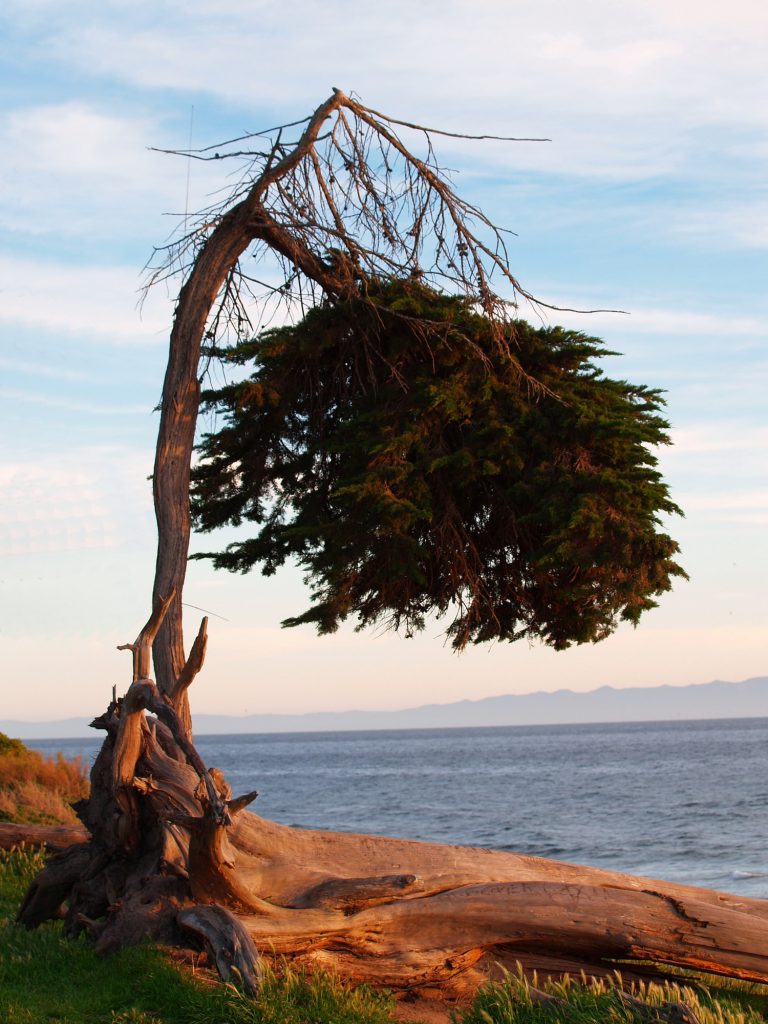
Senior Citizens Can Build Resilience Together
How Santa Barbara’s Senior Citizens Can Build Resilience Together
A Conversation with Julian Gresser, Chairman/ CEO of Big Heart Technologies and Dr. Gary Linker, Director Santa Barbara Center for Successful Aging
Gary: Julian, I am delighted to have this chance to explore the fascinating topic of resilience. Perhaps a good start is to define what you and I mean by resilience.
Julian: Good idea. The first thing that comes to mind for many people is an ability to bounce back from adversity. I like the bounce part, but why go backward to something that wasn’t so great in the first place? I view resilience as the capacity to bounce forward, to turn adversities to advantage.
Gary: I like this definition. It is dynamic and especially well-suited to our readers who face many medical, social, and economic challenges in aging.
Julian: I would like to suggest this basic proposition for our discussion: resilience is a core life competency that anyone can cultivate and easily apply in diverse ways.
Gary: Right out the gate, I must ask isn’t resilience a young person’s game, something that loses with age?
Julian: Not necessarily. The data from NASA and other studies suggest the opposite which may be counter intuitive. Resilience can hold steady, and in some cases even increase in advanced old age. Another common belief is that a loss of power inevitably comes with aging; but actually, this premise is also not necessarily correct. Even though physical power declines with age, we can still increase our inner power. I have trained with Chinese martial artists in their 80s and 90s who possessed amazing inner energy (qi) power. Resilience and such inner power naturally align.
Gary: I know what you mean. I just went to a Frankie Valle 4 Seasons concert. Frankie performed for 90 minutes. Guess what, he is 84! But, let’s get very basic here. I get up in the morning. What’s the first thing I can do to build my resilience?
Julian: Ok, let’s begin with physical resilience. if you do a Google search on the main diseases commonly associated with aging—diabetes, hypertension, cardiac problems, stroke, neurodegenerative illnesses, and cancer—you will find that all are closely related to a loss of resilience. The process is even intra-cellular. There is good evidence that mitochondria dysfunction correlates closely with an impairment of resilience.
Gary: So, what do I do?
Julian: You start to move. For when we move, we begin to change our relationship to the ground. As we get older, many of us have a great fear of falling. So, practicing getting up and lying down a few times, a brisk walk, dancing, taiji, even tango help to restore this dynamic positive relationship with the earth. I practice horse stance for 1-2 minutes. Horse stance is a half squat where I lower my center of gravity and connect to the earth, while neck and head are straight as if a line of thread is connecting me to the heavens. I also play with a Reflex Ball, which has taught me a great deal about play and resilience. The ball is attached to your head by a light cord. You strike it and it bounces back. You learn how to move rapidly or slowly in tune with the ball; there are some deep lessons here like “yielding power.” You strike hard, the ball comes back hard; yet, if you don’t react but give way, the ball will lose energy; and then you have your opening. The Bible says, “A soft word turneth away wrath.” The ball teaches us this. It is a mirror of our own developing resilience. Our readers may enjoy this Alliances short video.
Gary: I do agree that the cultivation of physical resilience is in part a personal practice; but as a therapist I am convinced, especially for seniors, the development of resilience is not a solo journey.
Julian: I agree with you. We have ample evidence that restoring a sense of meaning, belonging, and engagement is essential. Years ago, I was friends with a remarkable minister, the Reverend Mitsuo Aoki who was a professor at the Divinity School at the University of Hawaii. He cared for people in advanced stages of illness. He would tell me that when those in his care regained a sense of connection to community, healing began–not only in a spiritual sense, but also in many cases in remission or a complete return to robust health. This renewed sense of connection restored hope which engendered a positive attitude to their circumstances.
Gary: What are some practical ways you have found to build this sense of engagement to community? If I want to connect to others, how can I do that?
Julian: It starts with a specific attitude. Various studies show that “paying forward”—the act of selflessly passing on to others the good things that come our way– not only builds personal resilience but also generates a positive “multiplier effect” throughout communities. I first discovered this principle in my work in negotiation. In negotiation an important behavioral skill that can be developed is to reduce our dependency on others or circumstances (“field independence”), in other words to stay out of “need. Perhaps the most effective way to reduce neediness is to care for others. Charles Dickens wrote “No one is useless who can lighten the burdens of another.” Over the years I have been interested in tracking what happens when we reduce neediness and pay forward. I have discovered that good things tend to come to us in mysterious and often quite wonderful ways. I call it “Creating Your Own Luck.” It is a form of advanced skill that seems to show up as we develop resilience. I describe the process in detail in my online living book, Laughing Heart—A Field Guide to Exuberant Vitality for All Ages—10 Essential Moves.
Gary: What are some other simple things senior citizens can do to build or to restore resilience? For example, in another conversation we had discussed the role of beauty. How does that fit in here?
Julian: Ah, you are touching one of my favorite subjects. In fact, “Discovering Beauty” is number 3 in the 10 Essential Moves. Most people believe the enjoyment of Beauty is a passive process. But actually, discovering Beauty is itself a learned skill. The challenge is to expand our appreciation and enjoyment of what is beautiful. Most people can enjoy Beauty in a baby, a flower, the ocean, or a sunset. But can we also find beauty in ordinary things or difficult circumstances, in even ugly things? There is so much Beauty in the world to be discovered if we will only slow down and observe, rather than continually rushing through life. To me, this is one of the great opportunities of advancing age.
I have a friend who was the primary caregiver for his wife. She was declining rapidly from Alzheimer’s. When I spoke with him, he was despairing and close to burning out. Then his daughter moved back home and everything changed. He cherished the small moments of respite that gave him time and space for himself. He told me he began to discover beauty in little mundane things he had always taken for granted–like mowing the lawn or looking at products in the supermarket. Imagine selecting a detergent as an opportunity to discover Beauty! He was grateful again for his life.
Gary: It seems you are saying Beauty is connected to slowing down, being present to our current life experience; and that all of this helps us to reconnect to the world and to re-create ourselves. This renewed sense of connection is the foundation of resilience. If so, Nature must play a pivotal role in your work.
Julian: Nature is the archetypal teacher of resilience. The Wildling Museum in Solvang has just opened a special exhibit on “Regeneration and Resilience in Nature” featuring how the natural world here in the Coastal Area is gradually recovering from the Thomas Fire and mudslides. There is a famous Chinese poem that expresses well this insistent resilience of Nature from the crazy depredations of humans: “Although the kingdom was destroyed, the castle grasses and mountain flowers are once again in bloom.”
Gary: What about music? As you know, there is substantial work on the regenerative effects of music on memory, especially with people struggling with advanced Alzheimer’s disease.
Julian: As a musician (I play oboe d’amore) I am keenly interested in exploring the potentialities of music in developing resilience. The great masters, Bach, Mozart, Handel, Beethoven and others succeeded in transmuting their life force, or vitality into musical form, and the amazing thing is even today we can learn to “download” this same energetic power to fortify our own resilience. You and our readers can see for yourselves by simply listening to the excerpts under Move # 5. The performing arts are also marvelous means for communities to build and celebrate resilience. One of the members of our International Advisory Board members, originally a Russian expert at the Wilson Center for International Scholars in Washington, has studied this interesting phenomenon in depth. In performing arts festivals music, dance, joy, exuberance, play and engagement all come together in some marvelous alchemic process, and the result is resilience.
Dr. Roger Jahnke, a qigong teacher, author, and Chinese medical doctor practicing in Santa Barbara has written a very good book, “The Healing Promise of Qi” in which he describes in some detail how qi, or subtle vital energy, can transmit immediately across whole communities, especially when “heart” is engaged. In Western terms we might call it simply exuberance. The point is that when communities come together to celebrate anything that is imbued with heart and its attributes, joy, hope, love, play, and connection to our fellow voyagers, a deep community-wide and sustainable resilience occurs.
Gary: It seems in your view there are many roads to experiencing an enhanced sense of resilience. One other avenue that comes to mind is flow. Might flow have a role here?
Julian: Resilience as I experience it is also very much related to a sense of flow. Flow is the essence of our being. I believe you pointed out that for river rafters, the safe zone is in the middle is where the river flows easily and smoothly. Similarly, when we are in a harmonious flow, we move effortlessly. In Chinese culture this is referred to as Wu wei. But inevitably we are faced with obstacles and challenges. If we view these experiences as messages that we not in the flow, then we can adjust our perspective, look for the clues that the obstacles provide, and adjust accordingly. Heart, especially love, is a powerful energy field that can to melt obstacles. Thus, flow, Heart, love, and resilience are mutually reinforcing.
Gary: Can you help me connect a bit more directly resilience and Big Heart?
Julian: My colleagues and I have a name for what we have been discussing. We call it “Big Heart Intelligence,” or more simply “Integral Resilience.” When we open ourselves emotionally, the flood of energy surrounding the heart becomes activated. The human heart has an extraordinary ability to gather all the disparate parts, to see the world holistically. The dimensions of resilience we have been discussing—physical, emotional, energetic, cognitive, psychological, and spiritual—are all connected. When we enhance resilience in one domain, naturally it transfers to another, especially when the process is mediated by the Heart. We are currently developing a way to measure improvements in Integral Resilience and its associated Multiplier Effects.
Gary: Before concluding, I want your thoughts on how we can operationalize all of this. How can seniors in Santa Barbara, indeed the entire community, build resilience?
Julian. As you noted in our first meeting, it is all about engagement. We have developed a personalized, interactive, and intelligent online platform called the “CHME” (Community Health Multiplier Exchange) that will support the entire community in exploring, creating, learning, having adventures, challenging ourselves, making new friends, helping and caring for one another. Santa Barbara is blessed in so many ways. And surely one of our greatest treasures is the large number of talented people and dedicated non-profit organizations. But the present ecosystem is fragmented, vertically siloed by specialization, and unfortunately based on competition for limited philanthropic resources. In my opinion this is an outdated 20th century model that is poorly equipped to address so important a challenge as successful aging.
But what if there is a more compassionate 21st century path to motivate Santa Barbara’s diverse organizations to come together, to share ideas, products, and services, and thereby to enlarge the “pie” for everyone? This is not utopia. The technology and human resources required are all locally available; the cost, modest. The first beneficial and measurable outcomes in enhanced community resilience can be delivered within months. The first sign of an awakening resilience is to open ourselves to Seeing the Big Picture. Hopefully this interview will invite new comers to the conversation. I look forward to expanding our dialogue with those who attend one of our upcoming community presentations. The first will take place at Chaucer’s Bookstore on September 11th @ 7:00 pm. The second is a public presentation at Vista Del Monte Senior Community on Tuesday, October 23rd at 2 pm. Please come and invite a friend!
- Center for Successful Aging
- Dr. Gary Linker
- Julian Gresser Books: Piloting Through Chaos Trilogy: Wise Leadership/Effective Negotiation (1985), The Explorers Mind (2013) and Laughing Heart. (2017)
© Copyright Big Heart Technologies and Dr. Gary Linker, August 2018 All Rights Reserved
Resilience and the Reflex Ball
Resilience and the Reflex Ball:
At Play in the Fields of the World
“But I was much older then, I’m younger than that now.” Bob Dylan, Back Pages.
I turned 75 in June and have arrived at a turning point on the road. I have found most magical things happen in life by chance. I was introduced to the Reflex Resilience Ball (RRB) one lovely May day when I saw my friend, Stefan, practicing in the gym in Santa Fe with a ball that seemed to float, untethered. Upon further inspection I saw in fact that it was attached to his head, and he was well grounded as his martial arts training enabled him to be. Fascinated, I resolved to see for myself. Thus, began my journey.
As the video suggests, the practice is simple, uncontrived, and almost childlike: we meet and engage (Stefan calls it “negotiating”) with the ball. We move, it bounces, we respond. That’s it: simple, playful, joyful (bouncing power), and fun. We are not trying to gain anything. Just playing in the Fields of the World.
After a few hours of practice, I began to discover, with Stefan’s help and guidance. The original meaning of discovery from the Latin (discoupire) is to “find” or “uncover”. The RRB decided to reveal itself.
-
- The ball has a magical quality. It’s only a ball, of course, but then again…
-
- The ball is a mirror. How can it not be? After all, it is attached to our heads, and as Stefan reminds me (!) our heads sit upon our necks. I have come to learn from a new friend (introduced later), this is a non-trivial (re) discovery!
-
- The ball can teach us resilience at many levels (neurological, energetic, emotional, cognitive, psychological, even existential!) because it itself embodies resilience. In fact, the RRB is a master of resilience!
-
- The RRB can also help us to build “integrity.” In the Chinese and Japanese languages integrity (Chinese “te”; Japanese “toku) is written by the “hand” of action in continuous and dynamic balance with the “eye” of discovery and the “heart” of compassion. (See: www.explorerswheel.com)
-
- What does integrity have to do with the RRB and resilience? Well, everything. We are constantly being challenged in the practice to combine hand, eye, and heart. The greater the integrity, the greater the flow with the ball, the more resilience is enhanced.
-
- But how is heart involved? Because the more humble and relaxed and loose we are, and the more we quiet the heart, the greater the play, the quicker our reflexes. When we love what we do– here simply to play for the pure joy and sake of it– we naturally return to harmony and balance.
-
- RRB practice cultivates other virtues: patience, gravitas, connection to the earth, courage (when you strike the ball hard, it comes back at you very hard—isn’t this the definition of karma?—as you sow, so shall you reap?) when the ball comes at you sometimes very hard and fast, you must decide instantly, or you will get a wake-up call (very benign!) when it hits you. It reminds you, “Hello, I’m here!”
-
- Soon the RRB begins to communicate with us and we with it. For me it is in a subtle, non-verbal language. But wait! Of course it does, the RRB is you and I!
-
- As we practice we become freer. One day I had a kinesthetic image of being young again, bold and brash possessed with lightning speed and strength. I have always had the romantic image of myself as a samurai. When I first arrived in Japan at the age of 14, I had this odd sensation on that sultry July evening as the bus was transporting us from the old Haneda airport into downtown Tokyo, and while I was observing out of the window the women coming back from the public baths in yukata and geta that I had been here before. I knew I had. Years later, when I trained in the Kodokan judo institute and later at the main aikido dojo in Tokyo, I had the extraordinary feeling of the fierceness of a tiger, quite ridiculous and disproportionate to be sure, but I felt so alive then. It was these feelings and memories that flocked back to me suddenly when practicing with the RRB.
-
- Angela says she enters a state of “agelessness” which I believe is accurate. Time seems to pause. You are simply in the flow; some people might describe it as “the Zone.” I am free, at last. Because there is no more “I”.
-
- There is a close parallel with negotiation: I move, the other responds: the player who re-reacts often has the advantage. But this is where the analogy stops. No one is seeking advantage here, because both have the advantage—the advantage of play, joy, discovery, and youthful exuberance.
-
- We do gain some interesting insights into power: We actually do have some measure of “control” over the energy of the ball. For example, we can decide to strike hard, and then the RRB comes back hard on us. We then have a choice. We can strike back hard, or respond softly (the Bible says, “A soft word turneth away wrath.”) It’s exactly the same with the RRB. Or we can simply yield. We move aside and let the ball go wherever it chooses; and when its energy flags, we re-engage. I call this process “yielding power.” It’s one of my favorite moves.
-
- The RRB teaches acceptance. After all, it is attached to our head. We work with what we have, right in front of us, and the situation reveals itself.
-
- When I first began to practice I asked myself whether it might be possible to play with the RRB blind, like the Japanese heroic swordsman, Zatto Ichi. Immediately a voice intoned, “impossible!” But I have persevered. I can now with reasonable accuracy connect to the RRB about 40% of the time; and better if I will let go and relax even more—qigong Grand Master Li Junfeng calls this state “looseness” “no bones, like a snake!” I “listen” to the “field.” One develops an anticipatory sense of where the RRB is going to be.
-
- I can go on reporting my discoveries. But I think I should pause to reflect a moment:
Some Reflections
-
- If RRB practice teaches resilience and cultivates anticipatory power, how might this capacity translate into a broader ability to anticipate and to respond to dangers and risks in life?
-
- What is happening neurologically to us when practicing with the RRB? Dr. Joseph Migliore, a pioneer of brainstem balancing, calls this process “cross-crawling,” for it mimics how babies naturally play and develop brain hemispheric integration. His work focuses on carefully and subtly aligning and balancing two essential bones, the Atlas (named after the Greek hero who held up the world) and the Axis. These two bones like Scylla and Charybdis guard the channel of the brainstem that has an all-important influence on the afferent and efferent communication of nerves running through and beside it that regulate the primary autonomic processes of the body.
-
- What might be the influence of RRB on neuroplasticity? One interesting dimension of practicing with the RRB is the feedback is multisensory—sight, sound, touch, timing, emotions, etc. It hardly requires any effort at all to re-call this experience. It is living. In fact, I find I can practice in my mind alone, so powerful is the experience, without even holding the physical ball. When practicing in my mind I believe I am engaging both the brainstem and the cortex, which is interesting, because I am told the great ponderance of neuroplastic activity occurs in the cortex. They combine in my imagination. This brings me to the central dictum from Norman Doidge’s remarkable book, The Brain That Changes Itself (2007): nerve cells that fire together, wire together. Can we simply rewire as we practice with the RRB in our mind’s eye when we go to sleep?
-
- Why does the RRB appear to act as a magnet and attract curious and interesting people when I practice in public? Is it possible that when we connect to the RRB with a sense of joy, play, and love, this “good energy” bounces outward into the world and connects itself to others who are predisposed to receive it?
-
- What could be the deep offering from the RRB to an over-busy world reaching the heart of most of our present problems? Is it possible that by returning to a state of innocence, we can become a renunciate while also living in a world? Can this be a viable path for survival in this daily theatre of intolerance, violence, and upheaval?
-
- I listen to the bard, Bob Dylan around the fire for he tells us, “But I was much older then, I’m younger than that now.”
And for me there is another familiar spirit on the journey, Pu’tai. He seems to have answer, pointing us to the moon. https://en.wikipedia.org/wiki/Budai
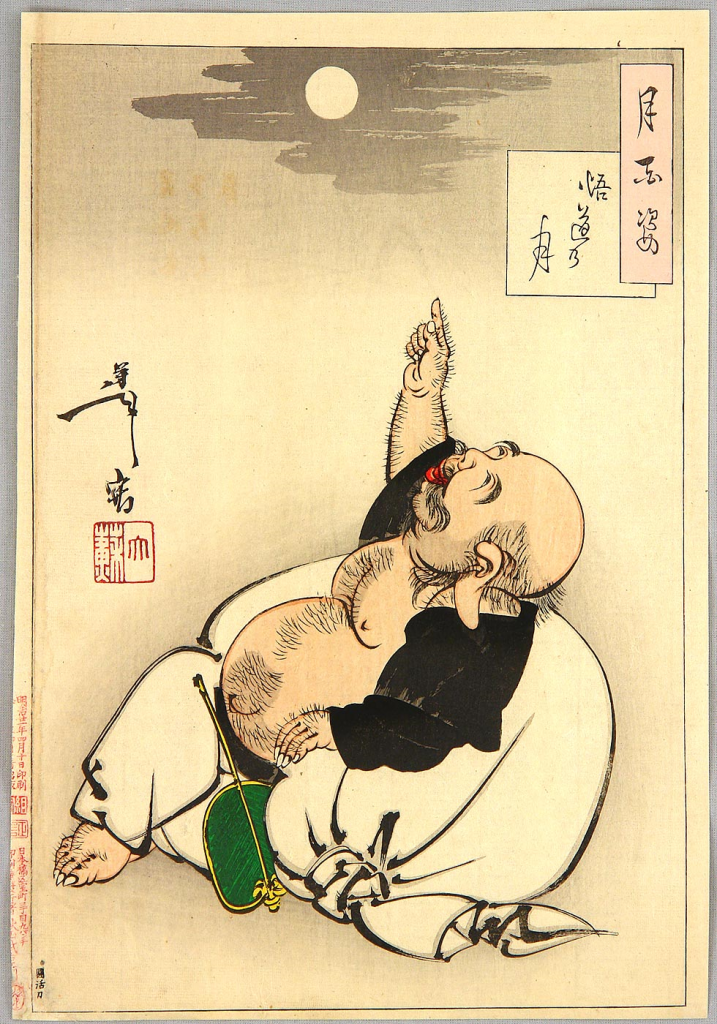
Tsukioka Yoshitoshi, Japanese (1839-1892)
Moon of Enlightenment, A depiction of Hotei, the god of happiness and good fortune.
color woodcut, 1888. From the series One Hundred Aspects of the Moon.


